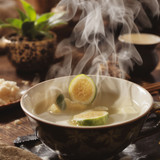

Starwest Botanicals
Organic White Tea Bags
White Tea Bags vs. Green Tea: Why They’re Different White tea and green tea come from the same plant—Camellia sinensis—but they’re made differently. That difference in processing is why white tea...
Ba Jiao Hui Xiang, also known as Star Anise, is a fragrant spice and powerful herb in Traditional Chinese Medicine. Prized for its warming effects, it supports digestion, eases bloating, promotes respiratory health, and has potent antimicrobial properties. Learn how to brew, cook, and benefit from this star-shaped botanical.
What looks like a beautiful spice in your chai might just be a digestive hero hiding in plain sight. Ba Jiao Hui Xiang (Star Anise) has been used for centuries in Chinese medicine as more than just a flavor enhancer—it's a go-to herb for warming the Middle Jiao, easing gas, promoting healthy breathing, and warding off unwanted microbes. Whether steeped in tea or simmered in broth, this star-shaped spice adds more than taste—it brings balance, protection, and ancient healing to the table.
 Quick Facts on Ba Jiao Hui Xiang (Star Anise)
Quick Facts on Ba Jiao Hui Xiang (Star Anise)Chinese Name: Ba Jiao Hui Xiang
Botanical Name: Illicium verum
Common Name: Star Anise
TCM Category: Herbs That Warm the Interior and Expel Cold
Meridians Entered: Spleen, Stomach, Kidney
Taste & Temperature: Pungent, Sweet / Warm
Dosage: 3–6g in decoction; 1–2g in powder form
Common Combinations: With Sheng Jiang (fresh ginger) or Chen Pi (aged tangerine peel) for digestive discomfort
Star Anise is the dried fruit of the Illicium verum tree and is known for its distinctive star shape and sweet-licorice aroma. It is not only a culinary spice used in Five-Spice Powder but also a warming herb in Chinese herbal medicine. It promotes the smooth flow of Qi, alleviates cold-induced pain, and strengthens digestion.
In TCM, Ba Jiao Hui Xiang is used to:
Warm the middle burner (especially the Stomach and Spleen)
Dispel cold from the abdomen
Alleviate pain from cold stagnation
Regulate Qi to relieve bloating and fullness
Support Kidney Yang
Its ability to "warm the interior" makes it valuable in cold patterns that show up as abdominal pain, nausea, or diarrhea. It also helps move stuck energy in the digestive tract, offering relief for bloating and gas.
 Suggested Use & Preparation For Star Anise
Suggested Use & Preparation For Star AniseDecoction (Tea):
Use 3–5g of whole dried star anise
Simmer in 2 cups of water for 15 minutes
Combine with cinnamon or ginger for added warmth
Powder:
1–2g per dose, added to honey, teas, or capsules
Culinary Use:
Add to stews, soups, and broths
Pairs well with fatty meats for digestive ease
This herb is ideal for individuals who:
Experience bloating or abdominal pain from cold
Have weak digestion or loose stools from Spleen Qi Deficiency
Want to support immunity during seasonal changes
Use it as part of Five-Spice blends for added herbal benefits
Avoid use or consult a qualified practitioner if:
You have heat-related conditions (Yin Deficiency with Heat)
You're pregnant (use under supervision only)
Using alongside prescription antivirals without practitioner guidance
| Herb | Best For | Why Combine With Star Anise |
|---|---|---|
| Ginger (Sheng Jiang) | Nausea, cold stomach | Amplifies warming and digestive effects |
| Chen Pi | Bloating, Qi stagnation | Enhances Qi movement and reduces phlegm |
| Rou Gui | Cold limbs, Yang deficiency | Deepens warming action for Spleen/Kidney |
Is Star Anise safe for daily tea?
Yes, in small quantities (1–2 pieces per cup). It can be used safely in digestive teas.
What’s the difference between Chinese and Japanese star anise?
Chinese star anise (Illicium verum) is safe and used in TCM. Japanese star anise (Illicium anisatum) is toxic and should NEVER be used.
Is star anise the same as anise seed?
No. They have similar flavors but come from different plants. Star anise is stronger, warmer, and used more in TCM.
Buy Ba Jiao Hui Xiang (Star Anise) – Premium Bulk Herb- See All Sizes Below

In the scrolls of ancient Chinese herbal apothecaries, Ba Jiao Hui Xiang was revered as one of the key “fire herbs”—plants that could rekindle the body’s inner warmth during the bitter chill of winter. It was commonly prescribed in yang-tonifying decoctions, especially for those who felt cold to the bone, had weak digestion, or experienced pain from cold invading the channels.
Sailors in Southern China and Southeast Asia carried star anise during long voyages. It was chewed whole or brewed into a strong tea to calm queasiness, prevent nausea from rough seas, and keep the stomach grounded—a practice passed on orally through generations of mariners and merchants.
In village kitchens, it played a dual role: a culinary spice and a protective herb. Families added it to fatty dishes like pork belly, duck, and oxtail—not just for its licorice-like flavor, but because it was believed to prevent “food stagnation” and help break down rich or heavy meals. The concept was simple but wise: warming herbs like Ba Jiao Hui Xiang stimulate digestive fire (Spleen and Stomach Yang), helping the body process food more efficiently and avoid bloat, belching, or nausea.
In Taoist folk tradition, star anise was sometimes burned during seasonal rituals to “push out cold demons” from the home and body—a symbolic gesture that aligned with its physiological role in dispelling cold and harmonizing the middle burner (Zhong Jiao).
During epidemic outbreaks in ancient towns, local healers included star anise in formulas to “open the chest” and prevent seasonal illness. Its penetrating aroma was thought to awaken and protect the Lung Qi, making it a common addition to home-brewed immune tonics.
Today, while it’s a staple in Chinese Five-Spice Powder, its legacy is more than culinary—it’s medicinal, protective, and deeply rooted in both ancient medicine and cultural resilience.
Ba Jiao Hui Xiang (Star Anise) is a fragrant, warming herb with centuries of use in both the kitchen and the clinic. Its ability to support digestion, ease gas and bloating, and contribute to immune resilience makes it a valuable ally, especially in colder seasons.
A 2020 comprehensive review of star anise details its antiviral, antimicrobial, antifungal, anti-inflammatory, gastroprotective, and antioxidant properties. It also highlights its key biochemical component: shikimic acid, used in the production of the antiviral drug oseltamivir (Tamiflu). Wikipedia+15PubMed+15Verywell Health+15
A 2022 study identified antiviral and antioxidant compounds in star anise fruit, isolating specific phytochemicals that outperformed Tamiflu in lab assays (H1N1 virus IC₅₀ = 1.74 µM vs. 10.01–10.76 µM for Tamiflu and ribavirin). PubMed
A 2021 investigation demonstrated that a polar fraction of star anise extract helps combat biofilm formation in MRSA and A. baumannii, offering promising anti‑virulence and antibacterial activity. Wikipedia+15PubMed+15PMC+15
Animal studies show star anise essential oil upregulates antioxidant enzyme activity (SOD, CAT, GSH‑Px) through Nrf2 pathway activation, helping reduce oxidative stress during E. coli challenge. PMC+5PMC+5PMC+5
A 2022 study demonstrated that polyphenol-rich star anise tea had anti-obesity and cholesterol-lowering effects in rats on a high-fat, high-sugar diet—suggesting digestive and metabolic benefits. Verywell Health+2PMC+2Health+2